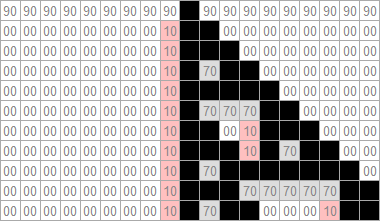Beginnings & the Use of Color
What made me decide not to usse color in this book were issues of visual perception. For much as it is easier to read text in black and white, so also it is easier to assimilate detailed pictures if they are just in black and white. And in fact many types of images in this book show quite misleading features in color. ...And particularly if there are few colors arranged in ways that are not visually familiar it is typical for all sorts of spurious patterns to appear.
A New Kind of Science, p. 851
When I first started with A New Kind of Science I created a spreadsheet which could generate cellular patterns so I could play along as I read. I scripted the spreadsheet not only to keep track of state of the target cells but also to track which rule was used to determine the state of the cell. And while I have since replaced the spreadsheet with scripted web pages, the approach remains the same.
What I do is assign two numbers to each cell. One number identifies the state of the cell, 1 for active and 0 for passive, and the second number indicates the rule used to determine the cell's state. If Rule 1 is the one that determines the state of a target cell and the state is active, the cell is assigned the label 11. If, on another hand, Rule 3 determines the state and the state is passive, the label is 30.
I am able to display the results of a ruleset in multiple ways using the additional information I've captured in the cell labels. I can generate traditional active/passive patterns by focusing only on the right-hand digit of the cell label; I can generate patterns which show the specific rules used by focusing only on the left-hand digit; and I can generate a mixtures of the two.
I continue to use black and white for the traditional active/passive patterns and I went with color for the rules display. I continue to assign black to Rule 7 and white to Rule 0 (except when I decide to use grays) and then assign rainbow colors to the remaining six rules, with red for Rule 1 and purple for Rule 6, like so:
| Rule 7: | 1 | 1 | 1 | |||||
| Rule 6: | 1 | 1 | 0 | |||||
| Rule 5: | 1 | 0 | 1 | |||||
| Rule 4: | 1 | 0 | 0 | |||||
| Rule 3: | 0 | 1 | 1 | |||||
| Rule 2: | 0 | 1 | 0 | |||||
| Rule 1: | 0 | 0 | 1 | |||||
| Rule 0: | 0 | 0 | 0 |
Here's an example of how the different patterns play out for Ruleset 124. Note that the colors for the passive cells have been muted to reflect the different state from the more bold active colors.
Pattern with active and passive cells:

Cells labeled and showing rules used:

Active cells combined with passive rules used cells:

What becomes clear from these examples is that more goes into the generation of the patterns than is shown by the traditional active/passive represenation. There can be a great deal of underlying activity where passive rules are invoked and become key players in the determination of the cellular pattern. Much of my investigation focuses on this underlying activity as I try to understand how the internal mechanics of elementary cellular automata work.
Going forward, the display of rules will combine the rule number, the rule pattern, and the rule color. Rule 3, with a pattern of 011 and color yellow becomes 3:011 .
Home
Prev: What a Cellular Automaton Is
Next: About Mirrors and Symmetry